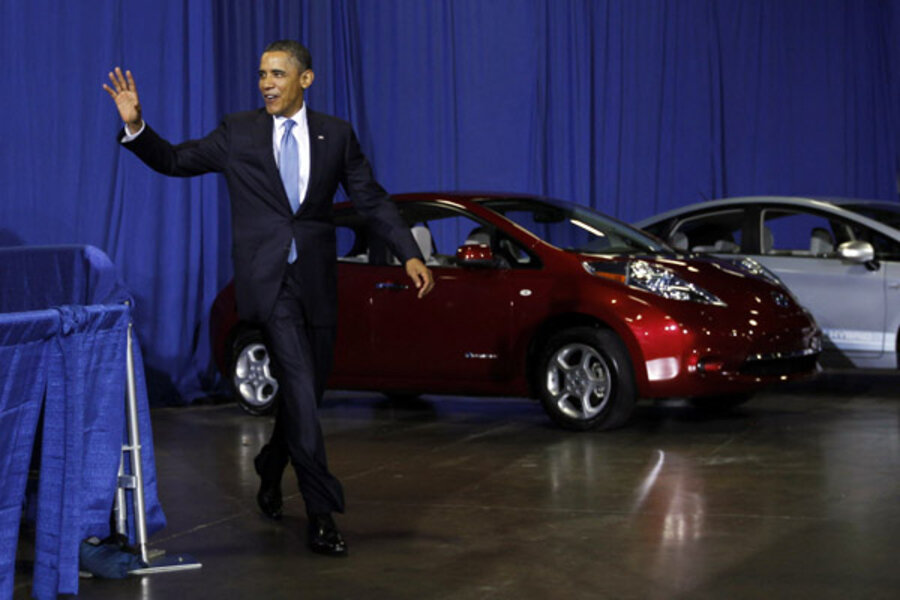Fuel efficiency: Will new rules cure US addiction to foreign oil?
President Obama on Friday unveiled a new set of vehicle fuel-efficiency standards that put the US auto industry on track to achieve a fleet average of 54.5 miles per gallon by 2025 – a big step toward cutting oil imports and reducing greenhouse-gas emissions, energy experts and environmentalists say.
The newly proposed standards, which more than double fuel efficiency compared with today's levels, follow close on the heels of earlier increases in fuel-economy standards, finalized in April. Under that previous rule, mileage will be raised to 35.5 m.p.g. by 2016, from about 24 m.p.g. today.
The new agreement would by 2025 cut US oil consumption by 2.2 million barrels a day – as much as half of the oil imported from OPEC each day, according to the Environmental Protection Agency. By 2030, it would also lower annual costs at the gas pump by more than $80 billion and cut annual carbon emissions from vehicle tailpipes by the equivalent output of 72 coal-fired power plants, according to a tally by the Union of Concerned Scientists.
But to get there, automakers must boost mileage 5 percent each year between 2017 to 2025. Light trucks would progress more slowly at 3.5 percent annually from 2017 to 2021, accelerating to 5 percent annually from 2022 to 2025.
“This agreement on fuel standards represents the single most important step we’ve ever taken as a nation to reduce our dependence on foreign oil,” Mr. Obama said in unveiling the standards at the Washington Convention Center, surrounded by an exhibit of new cars and flanked by auto executives. "We’ve set an aggressive target, and the companies here are stepping up to the plate.”
The deal has been embraced by the auto industry, which in negotiations in recent weeks won major concessions that mean it can largely meet the mileage standards with existing technologies, industry experts say. The industry will also have a single federal rule to follow, rather than multiple state rules.
“We share the Administration’s goal of achieving major advances in clean, fuel efficient vehicles," said James Lentz, president of Toyota Motor Sales USA, which is a member of the Alliance of Automobile Manufacturers, an industry group. "We look forward to working closely and constructively with the Administration and other stakeholders to ensure that we realize our shared environmental goals in the most economically-effective and consumer-friendly ways possible,” he said in a statement.
Energy-security experts praised the new agreement as key to reducing America's reliance on foreign oil.
"This is a big deal," Andrew Holland, senior fellow with the American Security Project, a bipartisan public-policy and research organization, wrote on his blog. "It is important that the United States as a whole uses less oil because the sheer volume of oil imports harms American competitiveness and drives down the value of the dollar."
The US spent at least $680 billion on oil imports in 2010, he writes. Without those imports, the US trade deficit of $497 billion in 2010 "would not have existed.” He continues, “That capital could be used for investment at home, and the export of that capital had the effect of driving down the value of the dollar."
The deal represents a compromise "win" for environmentalists, who had pushed for standards of 62 m.p.g. by 2025. Automakers initially responded that 45 m.p.g. was the highest they could go, saying the tougher standards would diminish profits and require building mainly electric and hybrid vehicles.
Some environmentalists saw the eventual deal as the best one possible under the difficult political climate in Washington.
“This is the single biggest step the president can take to lower drivers’ gas bills and cut heat-trapping pollution at the same time," said Roland Hwang, transportation director at the Natural Resources Defense Council, in a statement.
But others were less enthused, noting that loopholes could allow automakers to achieve the federal standard through technical means that save less gasoline than it might appear. For example, extra mileage credits will be granted for mild hybrid and strong hybrid pickups, and special credits will be granted for technologies such as louvered grills and solar roof cells.
"While the president’s proposal is a significant acceleration in the fight against global warming and oil addiction, it was weakened by auto industry lobbying," Dan Becker, director of the Safe Climate Campaign, said in a statement. "Automakers have seeded it with loopholes that weaken the oil, pollution and gas-pump savings."
Still, green advocates like Sen. Bernard Sanders (I) of Vermont called the deal "historic," noting it will save car owners at the pump, cut greenhouse emissions, and create jobs.
"By moving to 54.5 mpg, we can eliminate our reliance on Mideast oil by 2030," he said in a statement. "That's extraordinary and a great step forward for our country.”





